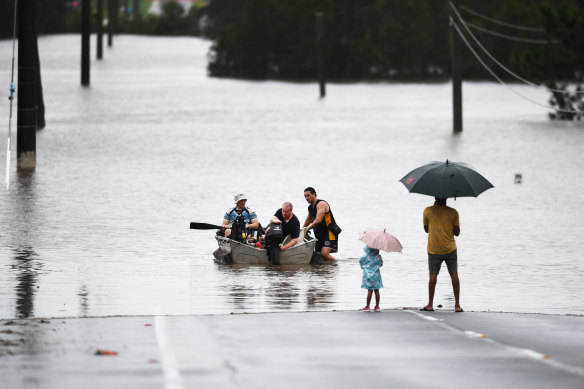- Updated
- National
- NSW
- NSW floods
This was published 3 years ago
‘Evacuate now’: Lismore residents told to leave as major floods hit NSW towns
By Jenny Noyes and Josh Dye
Lismore residents on the NSW North Coast were on Sunday night ordered to evacuate as major flooding engulfed the town.
Residents of South Lismore were ordered to leave their homes by 10pm on Sunday, with people in the CBD told to leave by 5am on Monday as floodwaters threatened to breach the levee.
The Wilsons River in Lismore was expected to breach its banks by 3am on Monday – two hours earlier than initial estimates. It was expected to reach at least 11.5 metres – equivalent to the March 2017 floods.
The evacuation orders come as a man is missing, feared drowned, when he was swept away in floodwaters in Lismore on Sunday afternoon after the region copped days of torrential rain.
About 4pm, police officers saw and heard a man calling for help, but they could not locate him and the search was suspended due to dangerous conditions.
Residents all along the coast of NSW were being warned to prepare for what could be life-threatening floods in coming hours and days, as the system lashing Queensland with heavy rain moves south.
The NSW State Emergency Service also issued evacuation orders for Kyogle and Tumbulgum, and issued warnings for other towns from Lismore to the Queensland border.
Major flood warnings were in place for Tweed, Clarence and Brunswick rivers, as well as Marshalls Creek.
Flooding was expected across Murwillumbah, Tumbulgum, Grafton, Ulmarra and Maclean, as well as Mullumbimby and Billinudgel.
Greater Brisbane was also bracing for thousands of homes to be inundated amid floods that have already killed six people in Queensland.
NSW Minister for Emergency Services and Resilience, Steph Cooke, said the risk of riverine and flash flooding “is very real over coming days” and implored residents not to be complacent.
She said she knew many of these communities “have seen [their] fair share of flooding” but urged them to heed warnings and get prepared by packing basic essentials in case of an evacuation order.
SES Commissioner Carlene York said the current threat was different to other flood situations, in that the ground “right across NSW” is already saturated.
“There is nowhere for it to go,” she said. Added to that are simultaneous high tides, which “make it very difficult for rivers to flow out into the ocean.”
Bureau forecaster Ailsa Schofield said rainfall wasn’t expected to ease in the north until Monday and “very serious, life-threatening flash flooding and riverine flooding is likely”.

The system that led to floods in south-east Queensland will move south to the NSW coast this week.Credit: Getty
Ms Schofield said the current forecast for Lismore was for major flooding to occur, albeit below the level of the 2017 floods from ex-Tropical Cyclone Debbie when 700 millimetres of rain fell in the area, but stressed “the rain that we’ve seen in Queensland has been torrential, and that system is moving to NSW”.
The immediate threat was to the north-east of the state, with 150 millimetres expected and potential for up to 250 millimetres to fall in those parts on Sunday and into Monday.
Coastal communities south of Sydney were told to prepare for a similar torrent on Wednesday.
Ms York said now was the time for people further south to prepare their homes by securing loose items and clearing gutters.
NSW Premier Dominic Perrottet also stressed the message to “please get ready, please be prepared and please follow the instructions as they are issued”.
He said there had already been 70 flood rescues since the wet weather began on Tuesday.
Ms York said she did not want to see a tragedy in NSW like the death of a Queensland SES volunteer whose vehicle was swept away en route to a rescue on Friday night.
The Queensland death toll rose to six on Sunday when the body of a 34-year-old man was discovered in the Brisbane suburb of Indooroopilly after his car was submerged in floodwaters at 2.30am on Sunday. Fears are also held for another man who disappeared after falling into the Brisbane River.
In NSW earlier in the week, a man died after his 4WD vehicle entered floodwaters on the Central Coast, while Ms York said crews had recently had to rescue a bus.
Ms York said people driving larger vehicles often think they can get through floodwaters, “and that really risks their life and risks those volunteers who go out and save those people when they call for assistance”.
Ms Cooke said the government is “deeply grateful” to the 550 SES volunteers working in the north of the state, telling them “we know you are tired, but we need you to keep going”.
The Morning Edition newsletter is our guide to the day’s most important and interesting stories, analysis and insights. Sign up here.